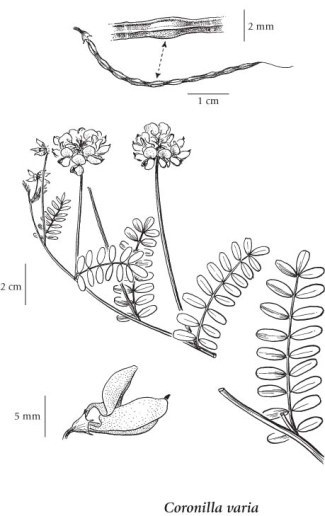common crown-vetch
Fabaceae (Pea family)
Introduction to Vascular Plants
Introduction
Crown vetch is an introduced perennial rhizomatous species in the Pea Family (Fabaceae) that is native to Europe, Asia and North Africa (Global Invasive Species Database 2011). In North America, it is found in across the United States and in most Canadian provinces (USDA 2011) where it occurs in disturbed areas, including along roadsides and railway tracks. In British Columbia, crown vetch has been introduced for erosion control along highways, and has naturalized in several locations in the southern part of the province. It is noticeably spreading in some areas (e.g. lower elevations of Cypress Mountain Road in West Vancouver).
Crown vetch is a pretty pink, purple, or white flowered species that can form a dense ground cover. It is considered an invasive species and is ecologically tolerant of a variety of conditions, including drought, heavy precipitation, cold temperatures, and a variety of soil types, although it is shade intolerant (Global Invasive Species Database 2011). In addition to use for erosion control, it has been widely planted in North America for ground cover, mine reclamation, as a cover crop, and as forage for livestock. (Global Invasive Species Database 2011). |
Species Information
General:
Perennial herb from extensive rhizomes; stems spreading, 20-100 cm long/tall, branched above, angled, glabrous.
Leaves:
Alternate, pinnately compound; leaflets 11 to 19, oblong to elliptic, 1-2 cm long, pointed, blunt or notched at the tip, papery-margined; stipules free, oblong, blunt-tipped, 2-5 mm long.
Flowers:
Inflorescence a long-stalked, axillary umbel of 10 to 20 pea-like flowers that nod in bud but are horizontal in full flower, the raceme-stalks usually longer than the leaves; corollas white to pink or purple, 10-12 mm long, the banner nearly round, with an arched claw longer than the calyx, the wings and keel with ear-like lobes toward the base, the keel purple-tipped; calyces bell-shaped, 2-3 mm long.
Fruits:
Pods, ascending-erect, curved, constricted between the seeds into several segments, linear, 4-angled, 2-6 cm long, breaking up into quadrangular segments; seeds 3 to 8 (10).
Illustration

If more than one illustration is available for a species (e.g., separate illustrations were provided for two subspecies) then links to the separate images will be provided below. Note that individual subspecies or varietal illustrations are not always available.
Illustration Source: The Illustrated Flora of British Columbia
Habitat and Range
Mesic to dry roadsides, railway tracks and waste places; rare, scattered throughout S BC; introduced from Europe.Status Information
Synonyms
Synonyms and Alternate Names:
Coronilla varia L.